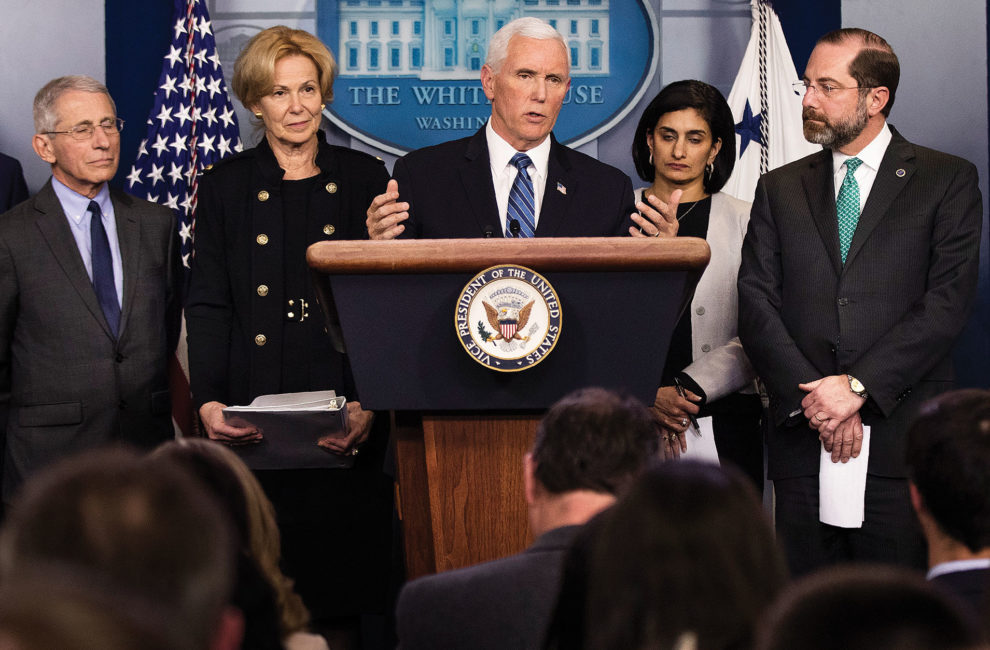Who Are The Hoosiers On The White House’s Coronavirus Task Force?

The White House Coronavirus Task Force, which is one-fifth Hoosier, has struggled with its, well, task. Photo by Manuel Balce Ceneta/AP Photo
Yes, the 22-person task force is 20 percent Hoosier. When President Trump officially formed it on January 29, it had just one member with strong Indiana ties: Secretary of Health and Human Services Alex Azar. But as the pandemic gripped the nation, that number shot up. On February 26, Vice President Mike Pence was tapped to lead the task force, and Surgeon General Jerome Adams, the state’s former health commissioner, joined the group. A few days later, Pence added the head of the Centers for Medicare and Medicaid Services, Seema Verma. Hoosiers may recall her as the architect of the Healthy Indiana Plan, the state’s alternative to traditional Medicaid, under former Gov. Mitch Daniels.
Adams is the nation’s top doctor. He’s the 20th surgeon general, the fourth African American to hold that office.
Back in Indianapolis, he was an actual doctor. He took shifts as an anesthesiologist at Eskenazi Hospital while serving as the state’s health commissioner.
That black, military-like uniform you see Adams wearing on TV? It’s from the U.S. Public Health Service Commissioned Corps. Part of Adams’s job is overseeing 6,500 uniformed health officers who work in “nearly 800 locations around the world, promoting, protecting, and advancing the health and safety of our nation,” according to his office.
This isn’t his first epidemic. On his first day in office under Pence in October 2014, Adams focused on preparing the state for a possible response to Ebola. Meanwhile, the state was still dealing with the aftermath of its first case of the MERS virus, recorded five months earlier.
Verma still lives in Carmel, but Adams moved his family out to D.C. full-time. “So they could be together as much as possible,” says Joey Fox, his former Indiana legislative director.
Alex Azar came up at Eli Lilly. He’s the 24th Secretary of Health and Human Services and was sworn in on January 25, 2018. He served as a senior executive at Lilly from 2007 to 2017. Azar, who still maintains a home on the north side, is the cabinet official who had the most responsibility in overseeing the administration’s early response to the virus.
The force’s official task: “Lead the Administration’s efforts to monitor, contain, and mitigate the spread of the virus, while ensuring that the American people have the most accurate and up-to-date health and travel information,” per a White House statement.
The latter part—providing accurate health information—has been a problem at times. Adams, for example, has mistakenly equated the virus to the seasonal flu. He also raised eyebrows (and prompted snickers on the late-night TV circuit) when he said that he isn’t as healthy as President Trump, since the 45-year-old Adams looks like the very picture of good health. Adams says he takes medication for six pre-existing conditions.

Jerome Adams was Indiana’s health commissioner from 2014 to 2017, when he became the U.S. surgeon general.Photo by Patrick Semansky/AP Photo
As recently as February 29, Azar downplayed the threat of COVID-19. “The risk to any average American is low from the novel coronavirus,” he said in a White House briefing.
It doesn’t help that Verma and Azar are locked in a blood feud. According to reporting by Politico and others, their fighting has slowed the nation’s response to the coronavirus. They rarely communicate, despite being on the same team. Last December, according to multiple news outlets, Trump tried to broker peace between the two in an Oval Office meeting. “They both survived,” one person familiar with their feud told Politico at the time. “Survival means they live to fight another day.”
And this was before anyone had even heard of COVID-19. The two have been in a “Cold War that got hot,” as Politico put it, ever since the fall of 2017, when Azar was chosen over Verma for his job. She had been a logical next selection, since she was second in command to the last guy, Tom Price.
Battle lines are being drawn. According to various news reports, rumor has it Jared Kushner and Melania Trump are in Azar’s camp, while Pence is Verma’s key supporter. The New York Times has also reported that Trump prefers to see Verma, not Azar, in front of cameras and giving interviews.
Hanging in the balance, meanwhile? The lives of millions of Americans.





